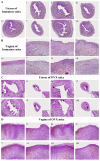Salvia miltiorrhiza bunge increases estrogen level without side effects on reproductive tissues in immature/ovariectomized mice
- PMID: 27997360
- PMCID: PMC5310662
- DOI: 10.18632/aging.101145
Salvia miltiorrhiza bunge increases estrogen level without side effects on reproductive tissues in immature/ovariectomized mice
Abstract
Salvia miltiorrhiza bunge(SM) is a popular herb for alleviating menopausal symptoms, although the scientific evidence of applying SM to estrogen replacement therapy is limited. In this study, we characterized the estrogenic activity of SM using in vivo models of immature and ovariectomized (OVX) mice and performed in vitro studies focusing on the estrogen receptor (ER) pathway for further molecular characterizations. SM treatments demonstrated significant estrogenic activity by promoting the development of uterus and vagina in immature mice, restoring the estrus cycle and reversing the atrophy of reproductive tissues in OVX mice, as well as increasing the expressions of ERα and ERβ at protein and mRNA level in the reproductive tissues. Meanwhile, SM significantly increased estradiol in serum, and decreased follicle-stimulating hormone (FSH) and luteinizing hormone (LH) in the circulation of immature and OVX mice. SM could stimulate the binding effect of ERα and ERβ, and significantly induce ERα/β-estrogen response element (ERE) luciferase reporter gene expression. All these activities were inhibited by the ER antagonist ICI182, 780. This study demonstrates SM exerts estrogenic effects by stimulating biosynthesis of estrogen and increasing ERs in target tissues without side effects on reproductive tissues and through ER-ERE-dependent pathway.
Keywords: Salvia miltiorrhiza bunge; estrogen receptor antagonist ICI182, 780; estrogen receptors; estrogenic effect; reproductive target tissue.
Conflict of interest statement
The authors declare no conflict of interest.
Figures









Similar articles
-
Veratrum nigrum inhibits the estrogenic activity of salvia miltiorrhiza bunge in vivo and in vitro.Phytomedicine. 2018 Apr 1;43:68-77. doi: 10.1016/j.phymed.2018.03.038. Epub 2018 Mar 19. Phytomedicine. 2018. PMID: 29747756
-
Radix Paeoniae Alba increases serum estrogen level and up-regulates estrogen receptor expression in uterus and vagina of immature/ovariectomized mice.Phytother Res. 2019 Jan;33(1):117-129. doi: 10.1002/ptr.6205. Epub 2018 Oct 29. Phytother Res. 2019. Retraction in: Phytother Res. 2021 May;35(5):2837. doi: 10.1002/ptr.6994. PMID: 30375037 Retracted.
-
Long-time qingyan formula extract treatment exerts estrogenic activities on reproductive tissues without side effects in ovariectomized rats and via active ER to ERE-independent gene regulation.Aging (Albany NY). 2019 Jun 19;11(12):4032-4049. doi: 10.18632/aging.102035. Aging (Albany NY). 2019. PMID: 31219800 Free PMC article.
-
Estrogen receptor-α and estrogen receptor-β in the uterine vascular endothelium during pregnancy: functional implications for regulating uterine blood flow.Semin Reprod Med. 2012 Jan;30(1):46-61. doi: 10.1055/s-0031-1299597. Epub 2012 Jan 23. Semin Reprod Med. 2012. PMID: 22271294 Free PMC article. Review.
-
The dynamics of estrogen receptor activity.Maturitas. 2006 Jul 20;54(4):315-20. doi: 10.1016/j.maturitas.2006.04.016. Epub 2006 Jun 5. Maturitas. 2006. PMID: 16753274 Review.
Cited by
-
Danshen (Salvia miltiorrhiza) protects ovariectomized rats fed with high-saturated fat-sucrose diet from bone loss.Osteoporos Int. 2018 Jan;29(1):223-235. doi: 10.1007/s00198-017-4254-2. Epub 2017 Oct 23. Osteoporos Int. 2018. PMID: 29058051
-
Estrogenic Effect of the Extract of QingYan Formula on Reproductive Tissues in Immature Mice.Evid Based Complement Alternat Med. 2019 Jan 8;2019:5493714. doi: 10.1155/2019/5493714. eCollection 2019. Evid Based Complement Alternat Med. 2019. PMID: 30728846 Free PMC article.
-
Dihydrotanshinone I inhibits human glioma cell proliferation via the activation of ferroptosis.Oncol Lett. 2020 Oct;20(4):122. doi: 10.3892/ol.2020.11980. Epub 2020 Aug 13. Oncol Lett. 2020. PMID: 32863935 Free PMC article.
-
Suppression Effect of Astaxanthin on Osteoclast Formation In Vitro and Bone Loss In Vivo.Int J Mol Sci. 2018 Mar 19;19(3):912. doi: 10.3390/ijms19030912. Int J Mol Sci. 2018. PMID: 29562730 Free PMC article.
-
Chinese Medicines Improve Perimenopausal Symptoms Induced by Surgery, Chemoradiotherapy, or Endocrine Treatment for Breast Cancer.Front Pharmacol. 2019 Mar 15;10:174. doi: 10.3389/fphar.2019.00174. eCollection 2019. Front Pharmacol. 2019. PMID: 30930771 Free PMC article. Review.
References
-
- Burger H. Hormone replacement therapy in the post-Women's Health Initiative era. Report a meeting held in Funchal, Madeira, February 24-25. Climacteric. 2003:11–36. - PubMed
MeSH terms
Substances
LinkOut - more resources
Full Text Sources
Other Literature Sources

